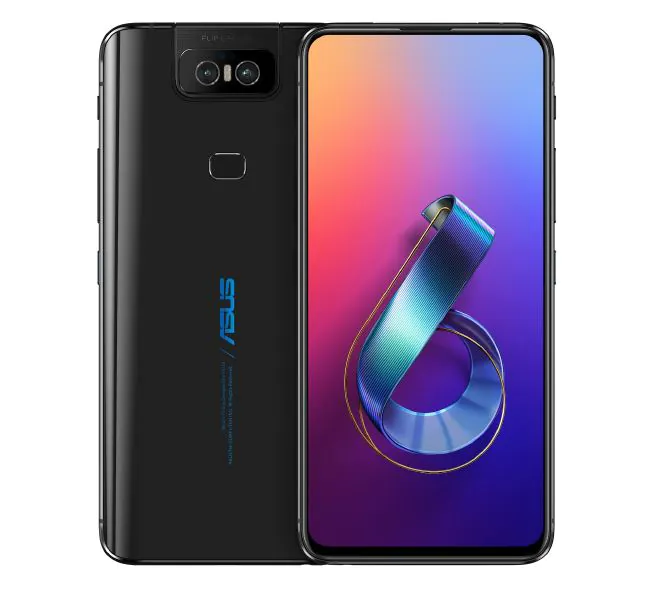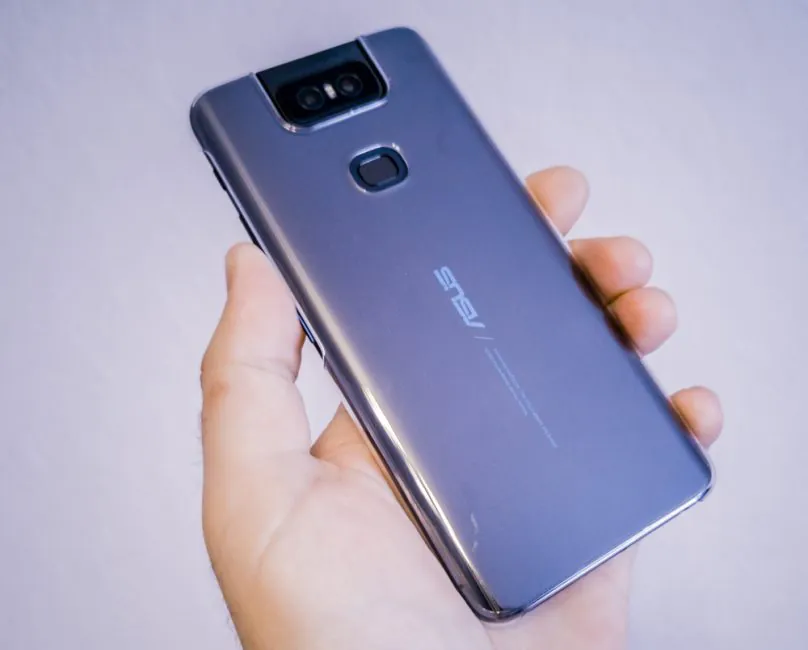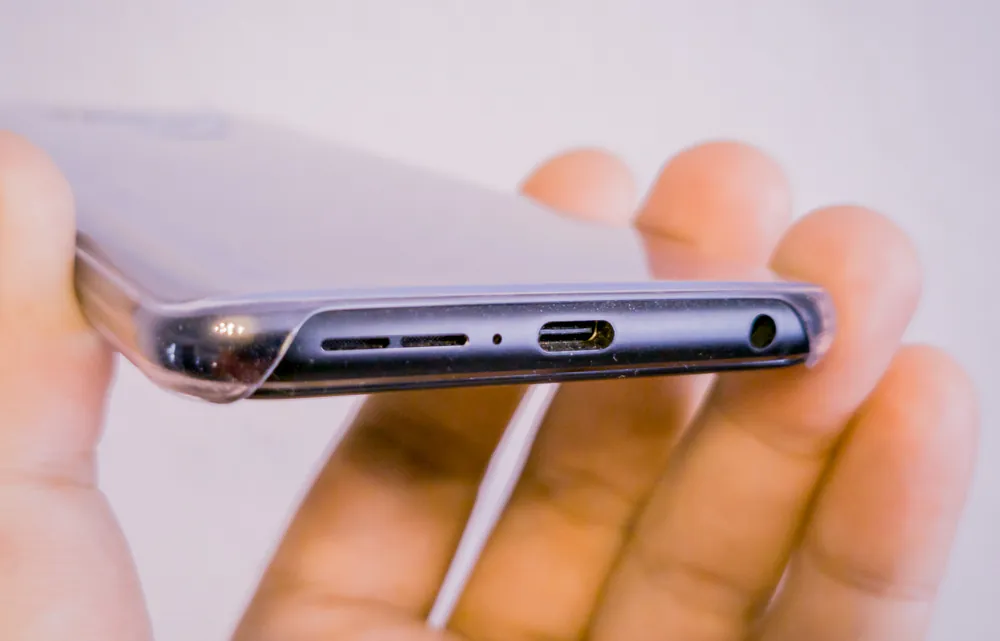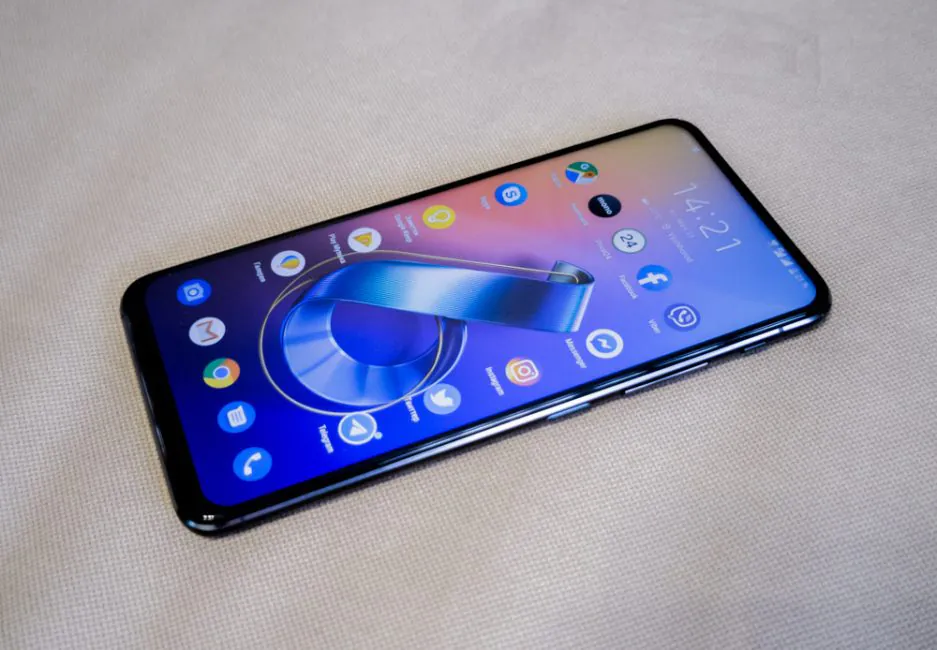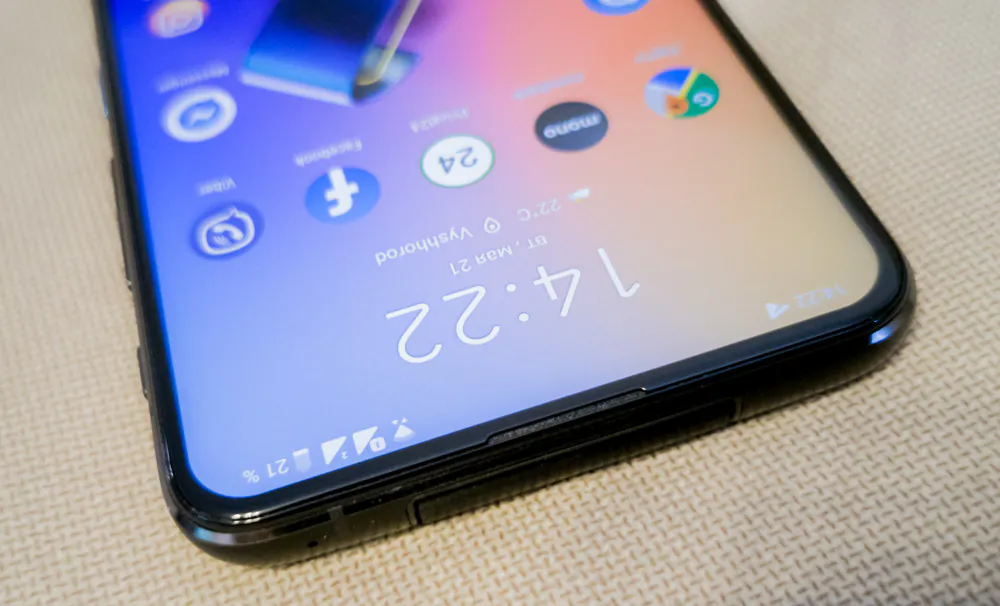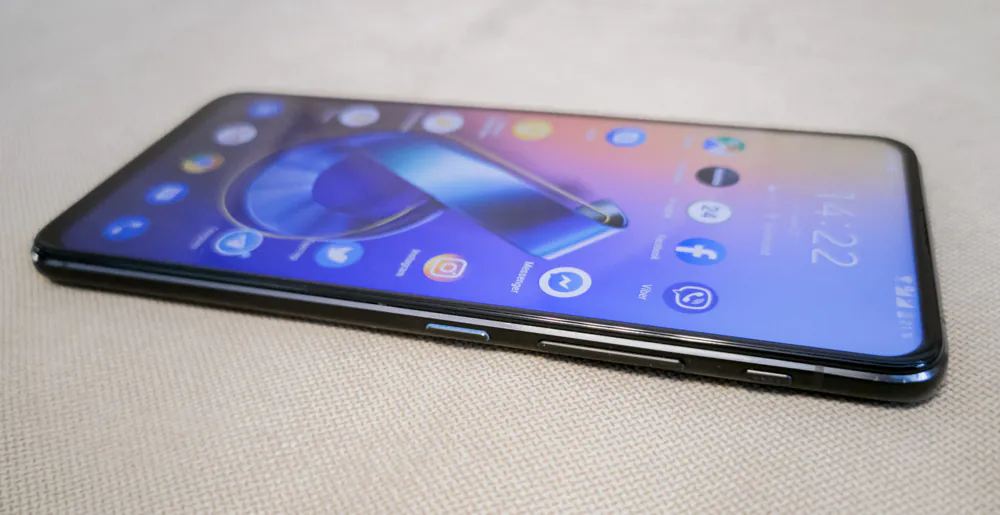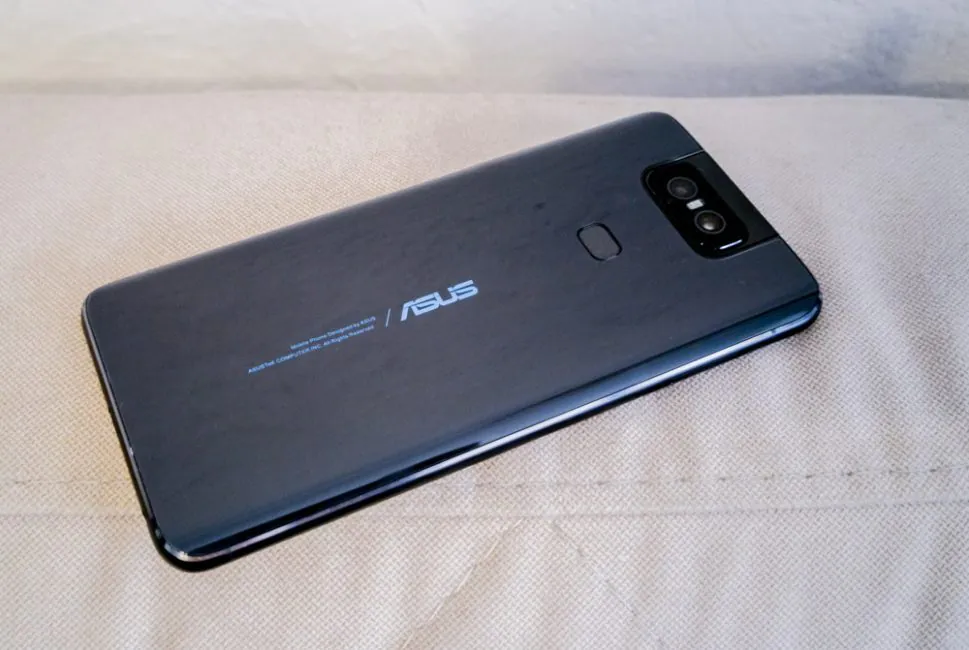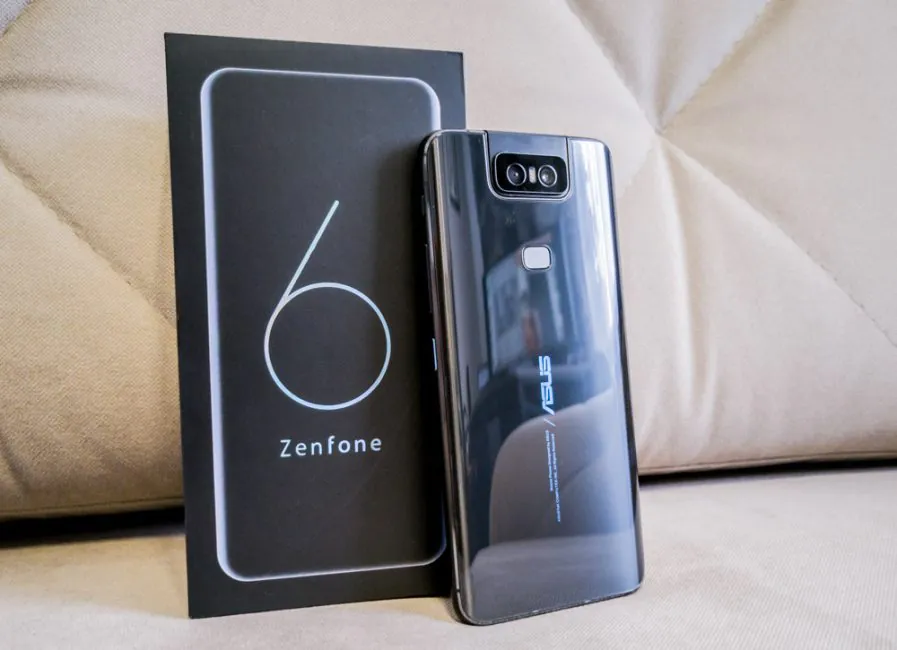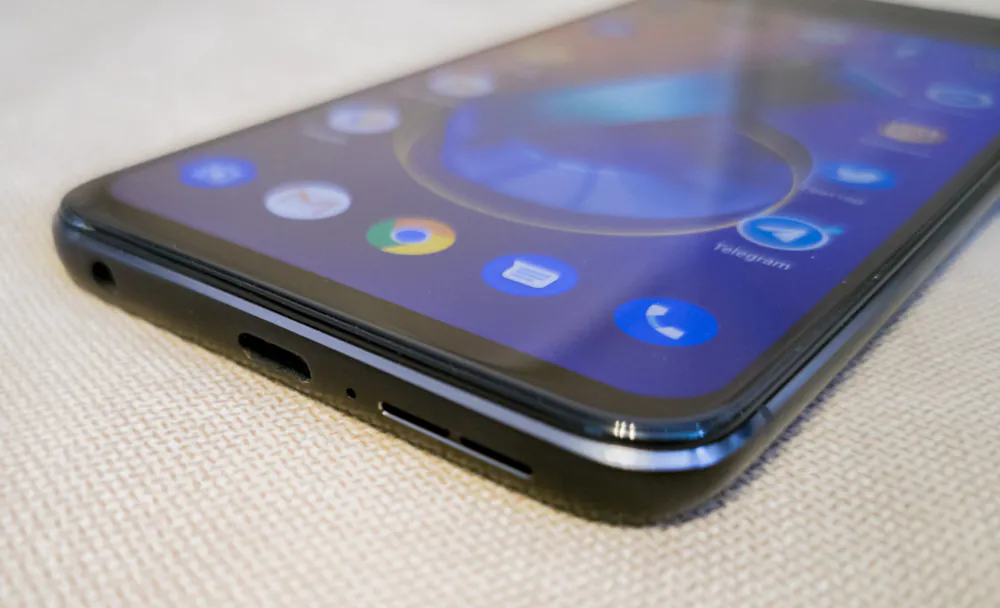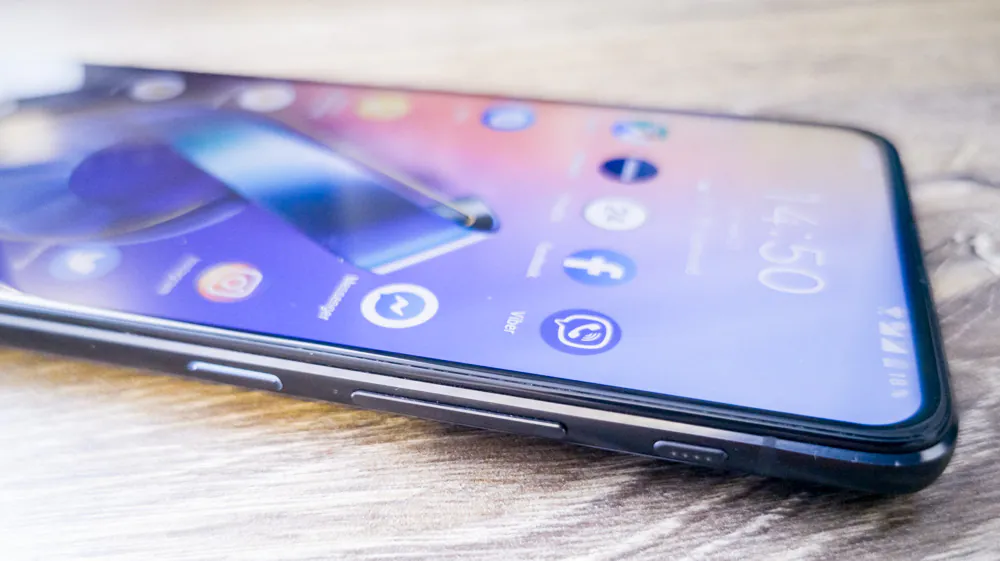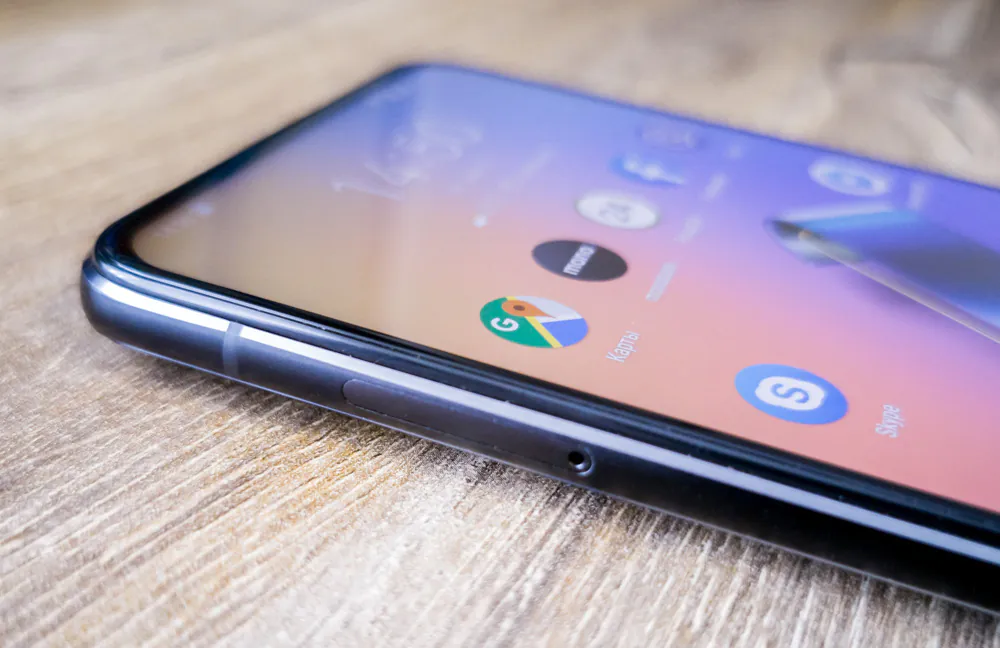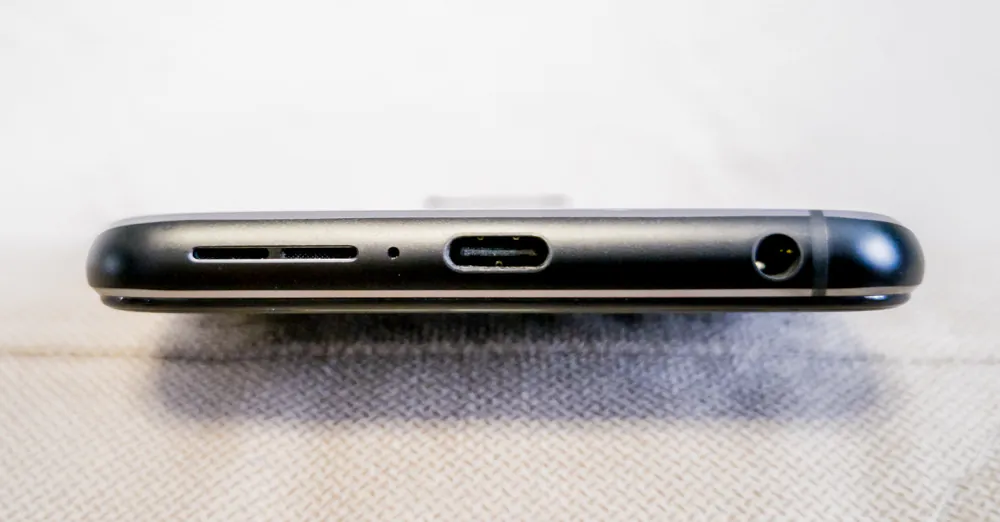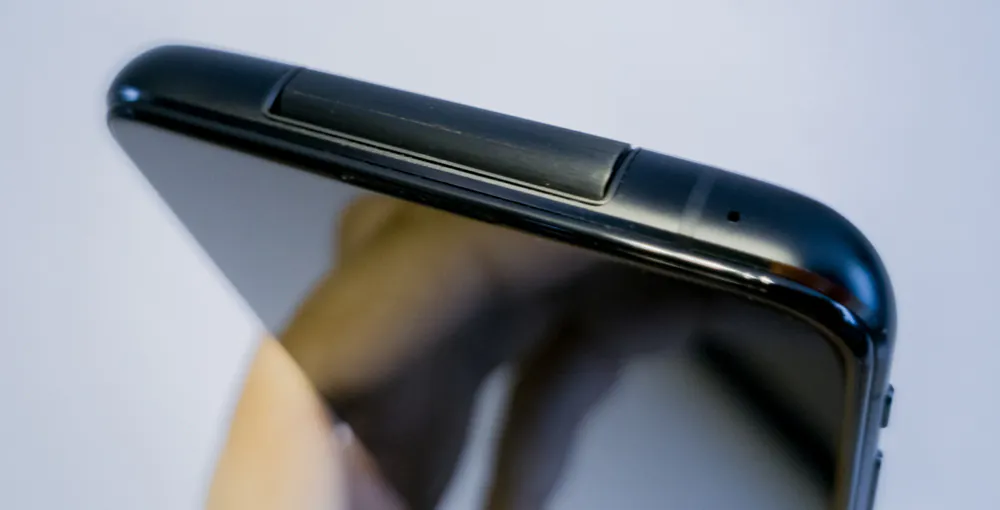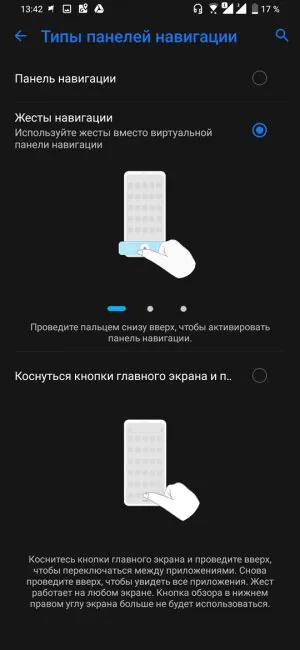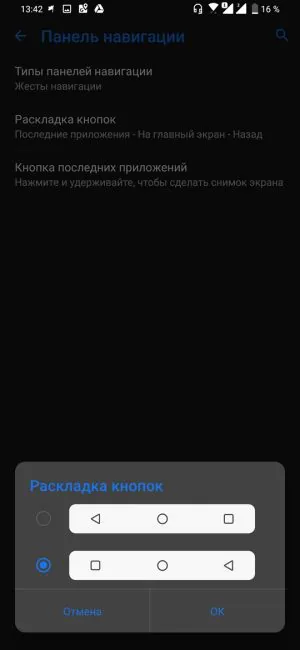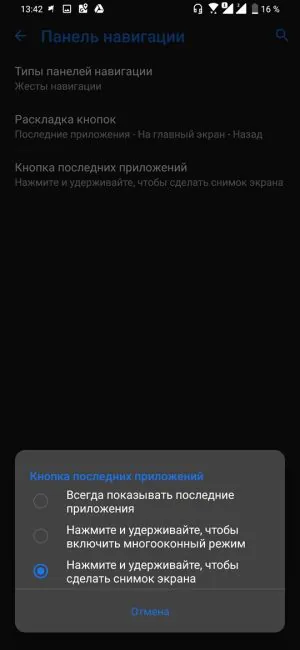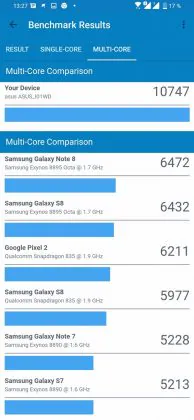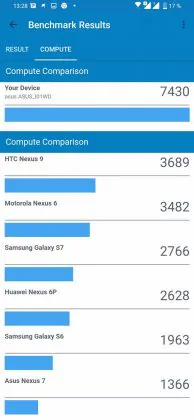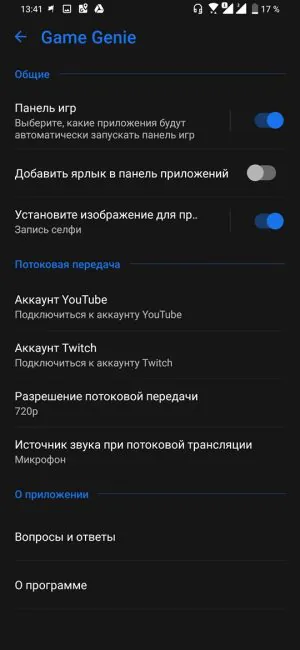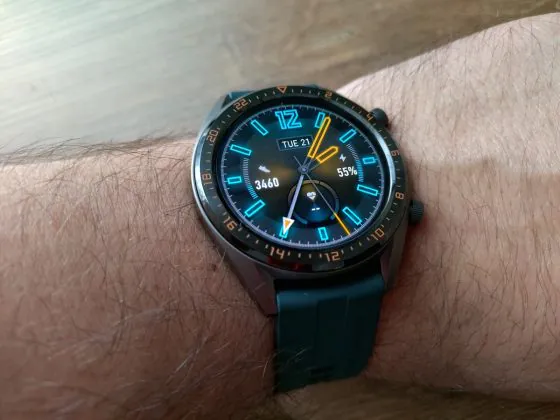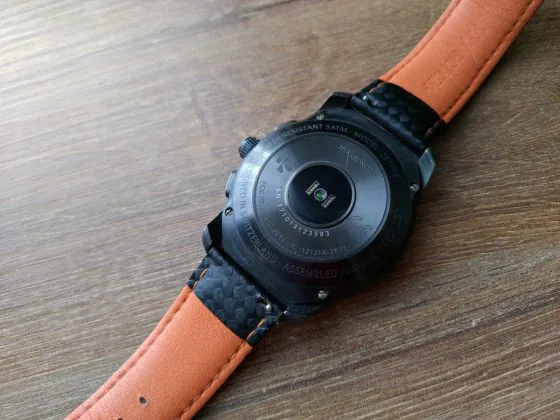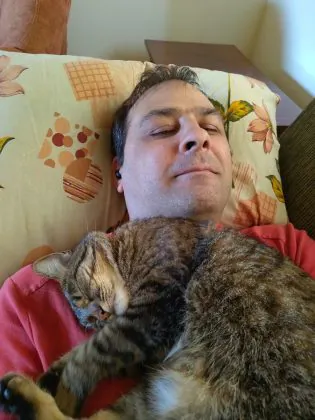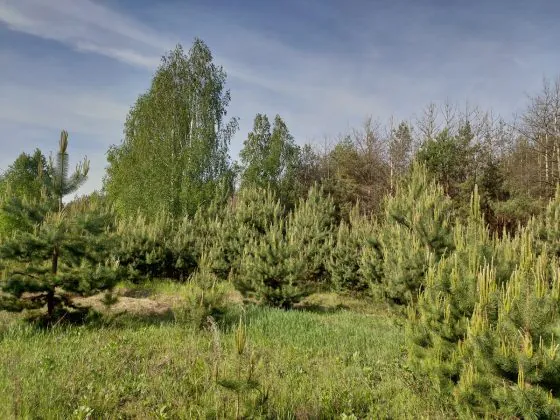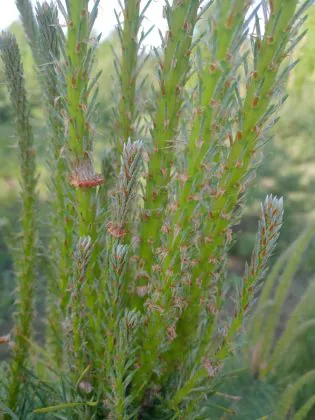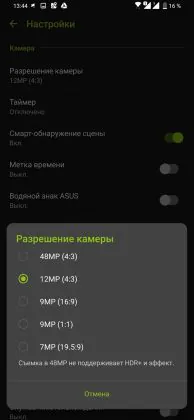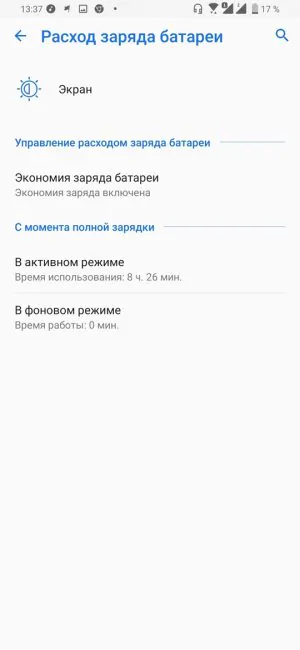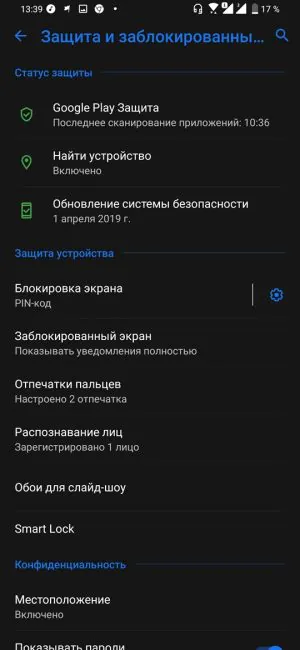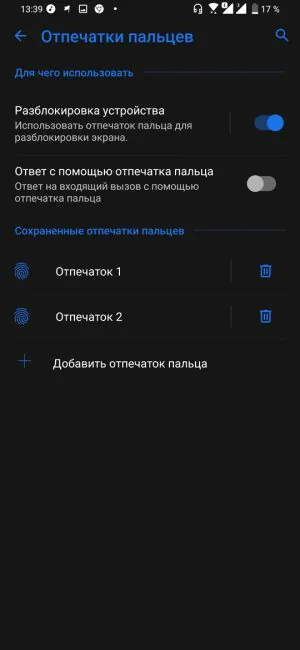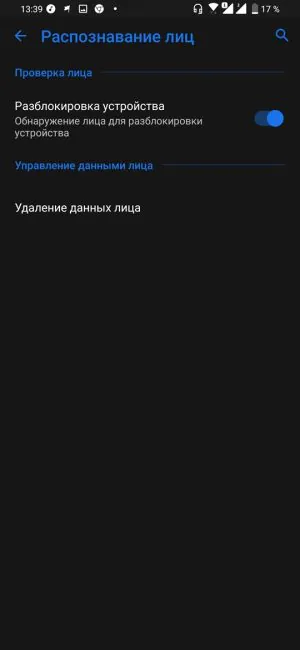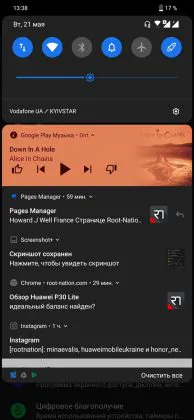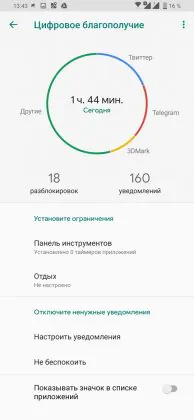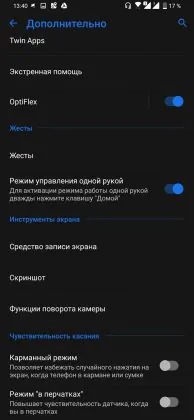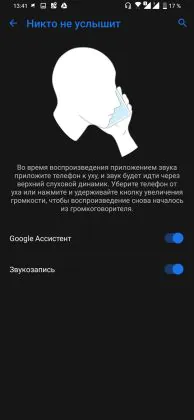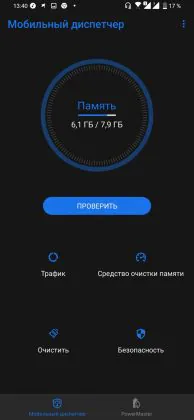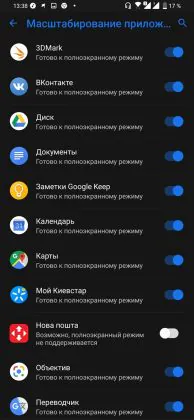© ROOT-NATION.com - Use of content is permitted with a backlink.
ASUS was surprised us with ZenFone 5Z in 2018 – the first adequate and truly competitive flagship smartphone in the company’s history. I expected ASUS to continue the trend by releasing something even better. It kinda happened after the release of ROG Phone, but I still didn’t expect that ASUS ZenFone 6 will be as good as it is. In fact, it’s one of the first ever phones with rotating cameras. Let’s take a closer look at this revolutionary device.
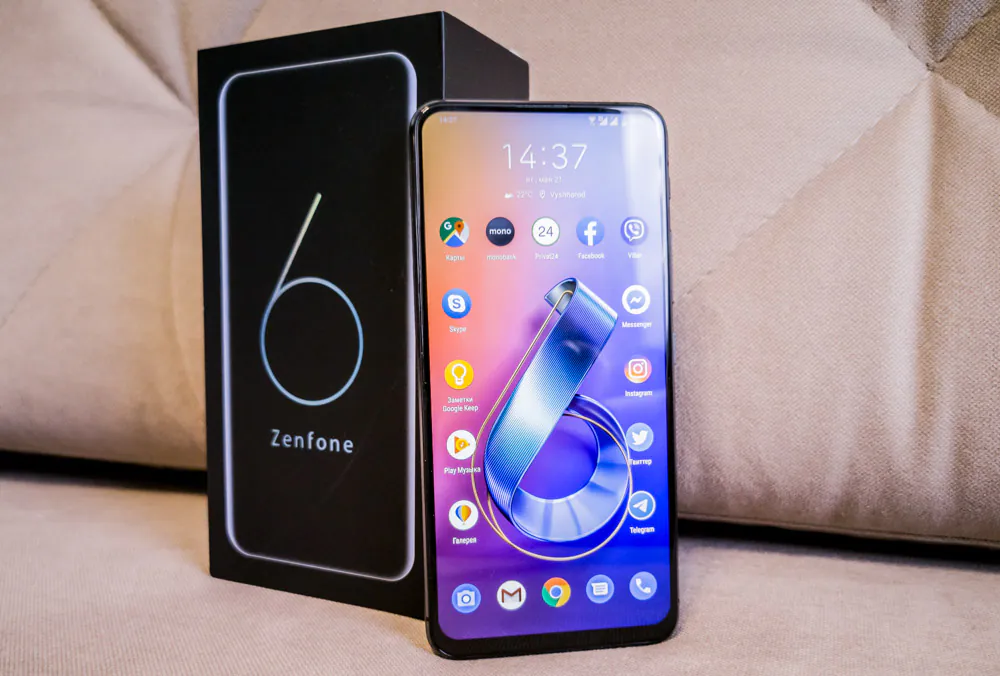
Our video about ASUS ZenFone 6
A short video – only the most important thing! If you need more detailed information – read the review below.

ASUS ZenFone 6 specs
According to GSMArena (and edited by me):
| Networks | Technology | GSM / HSPA / LTE |
|---|---|---|
| 2G | GSM 850 / 900 / 1800 / 1900 – SIM 1 & SIM 2 | |
| 3G | HSDPA 850 / 900 / 1900 / 2100 – A version | |
| HSDPA 800 / 850 / 900 / 1700(AWS) / 1800 / 1900 / 2100 – B version, C version | ||
| 4G | LTE band 1(2100), 2(1900), 3(1800), 5(850), 7(2600), 8(900), 20(800), 28(700), 38(2600), 40(2300), 41(2500) – A version | |
| LTE band 1(2100), 2(1900), 3(1800), 4(1700/2100), 5(850), 7(2600), 8(900), 18(800), 19(800), 26(850), 28(700), 38(2600), 39(1900), 41(2500), 46 – B version | ||
| LTE band 1(2100), 2(1900), 3(1800), 4(1700/2100), 5(850), 7(2600), 8(900), 12(700), 17(700), 18(800), 19(800), 26(850), 28(700), 38(2600), 39(1900), 41(2500), 46 – C version | ||
| Speed | HSPA 42.2/5.76 Mbps, LTE-A (5CA) Cat18 1200/150 Mbps | |
| GPRS | Yes | |
| EDGE | Yes |
| Launch | Announced | 2019, May |
|---|---|---|
| Status | On sale since May 2019 |
| Body | Dimensions | 159,1 x 75,4 x 9,2 мм |
|---|---|---|
| Mass | 190 г | |
| Materials | Glass on the front (Gorilla Glass 6), glass on the back (Gorilla Glass), aluminium on the perimeter | |
| SIM | Dual SIM (Nano-SIM) |
| Display | Type | IPS LCD capacitive touchscreen, 16 million colors |
|---|---|---|
| Size | 6.4 inches, 100.5 cm2 (~ 83.8% of the frontal area) | |
| Resolution | 1080 x 2340, aspect ratio 19.5:9 , 403 ppi | |
| Protection | Corning Gorilla Glass 6 | |
| Standards | DCI-P3 100% HDR10 |
| Platform | OS | Android 9.0 (Pie), ZenUI 6 |
|---|---|---|
| Chipset | Qualcomm SDM855 Snapdragon 855 (7 nm) | |
| CPU | 8-core (1×2.84 GHz Kryo 485 & 3×2.41 GHz Kryo 485 & 4×1.78 GHz Kryo 485) | |
| GPU | Adreno 640 |
| Memory | Slot | microSD, up to 1 TB (not combined) |
|---|---|---|
| RAM | 256 GB, 8 GB RAM or 64/128 GB, 6 GB RAM |
| Camera | Double | 48 Mp, f / 1.8, 26 mm (wide angle), 1/2 “, 0.8 µm, Laser / PDAF 13 Mp, f / 2.4, 11 mm (ultra wide) |
|---|---|---|
| Features | Dual-LED flash, HDR, auto panorama (motorized rotation) | |
| Video | 2160p@30/60fps, 1080p@30/60/240fps, 720p@480fps; gyro-EIS (except @240/480fps) |
| Selfie | Double | Rotating block |
|---|---|---|
| Features | Dual-LED flash, HDR, auto panorama (motorized rotation) | |
| Video | 2160p@30/60fps, 1080p@30/60/240fps, 1080p@30fps, 720p@480fps; gyro-EIS (except for @240/480fps) |
| Sound | Speaker | Stereo |
|---|---|---|
| 3.5 mm jack | Yes | |
| 24-bit / 192 kHz audio Active noise reduction with a dedicated microphone DTS Headphone X |
| Communication | WLAN | Wi-Fi 802.11 a/b/g/n/ac, dual-band, Wi-Fi Direct, hotspot |
|---|---|---|
| Bluetooth | 5.0, A2DP, LE, aptX HD | |
| GPS | A-GPS, GLONASS, BDS, GALILEO, QZSS | |
| NFC | Yes | |
| Radio | FM-радио | |
| USB | 2.0, Type-C 1.0 |
| Other | Sensor | Fingerprint scanner in the back, accelerometer, gyroscope, approach, compass |
|---|
| Battery | Battery | Non-removable Li-Po 5000 мАч |
|---|---|---|
| Charge | Quick Charge 18 W (Quick Charge 4.0) Power Bank / 10 W reverse charge |
|
| Lasts | To 624 h (3G) | |
| Speaking time | To 33 h (3G) |
| Other | Colors | Midnight Black, Twilight Silver |
|---|---|---|
| Models | ASUS_I01WD, ZS630KL | |
| Price | About 500-600 EUR |
Positioning and price
Aflagship is a flagship and that says it all. The characteristics of the smartphone are top and seem to be quite competitive, and in some respects (for example, battery capacity) are better than most. But there are some noticeable compromises – for example, the lack of moisture protection and wireless charging. Prices fluctuate around 500-600 euros. ASUS ZenFone 6 is one of the most affordable flagship smartphones in 2019.
What’s in the box
In the box, besides the smartphone itself, we find a rich package bundle – in addition to the standard cable, charging adapter, SIM card eject tool and pieces of paper, there is a plastic transparent bumper cover and a headset with a set of interchangeable tips. Just incredible generosity in our trying times.
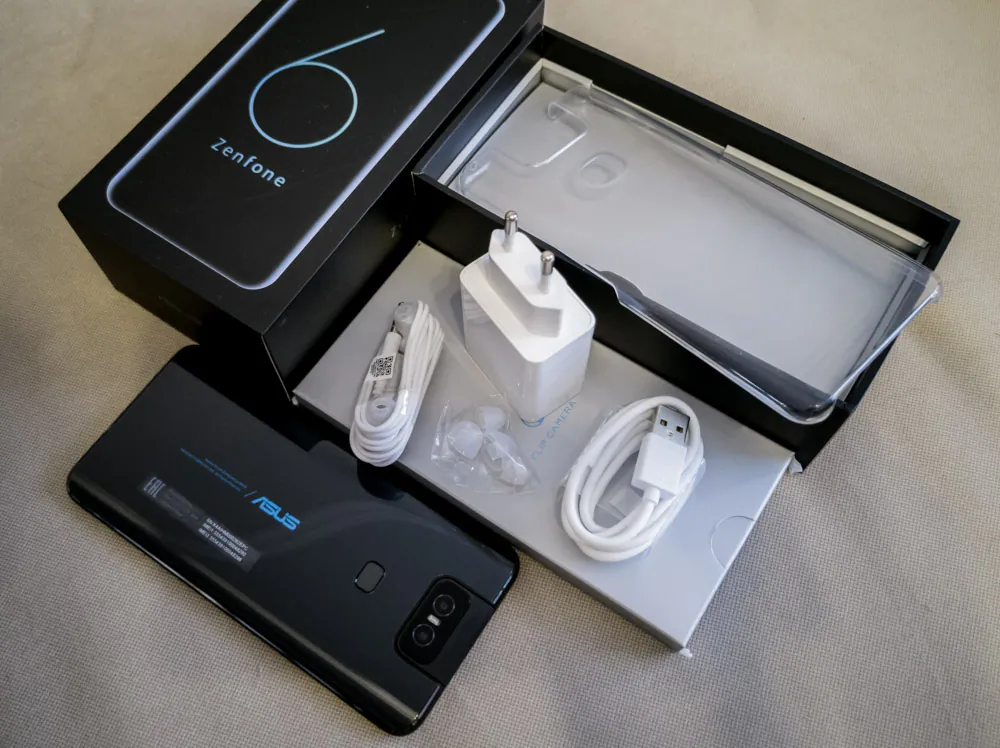
Of course, the case is simple and not very good, it’ll do until you buy something better. The sound of the bundled headphones is also quite good for undemanding users.
Design, materials, elements’ configuration and build quality
On the one hand, in ZenFone 6 everything is standard for the smartphone industry in general and the flagship segment in particular. Metal frame and glass front and back. But there are two things that attract attention.
Rather, in the first case, just the absence of an element – the front camera. No extra parts in front, no notches, drop-shaped or otherwise, and as a result the smartphone looks cool with the huge screen. Although the field below is quite large (why – I will tell later), which spoils the first impression a bit. But on top and on the sides the bezels are minimal. By the way, the front of ZenFone 6 has a protective Corning Gorilla Glass 6 glass.
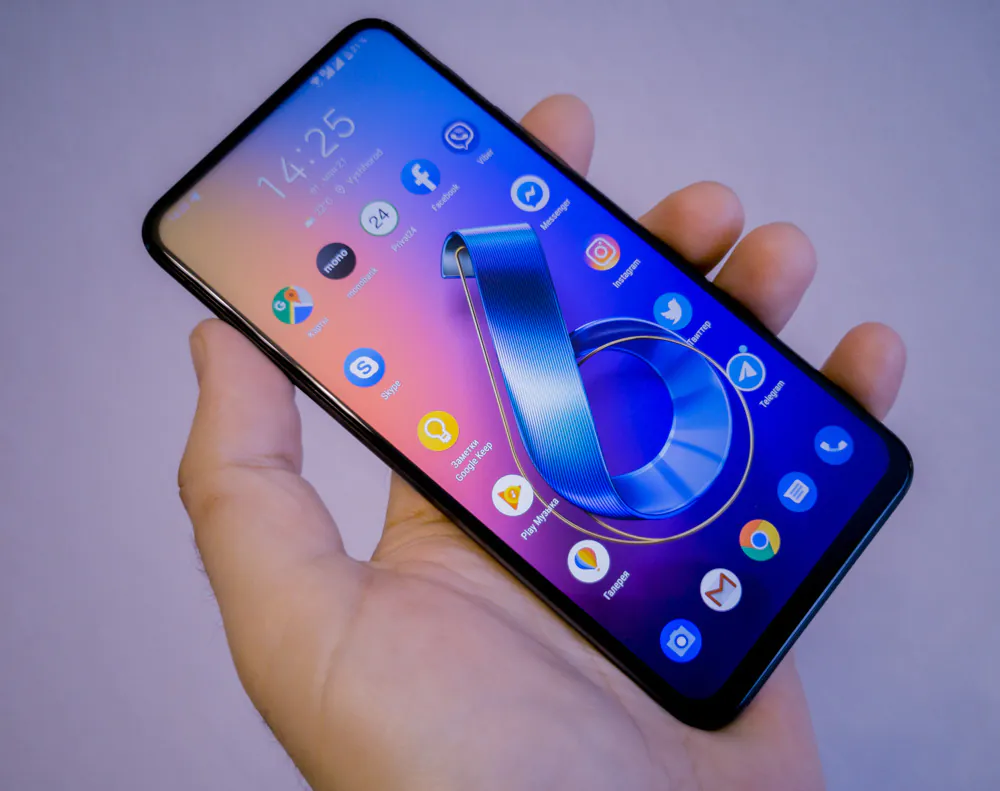
Above the screen is a speaker, light and proximity sensors. I am glad that there was also a place for the LED indicator, many manufacturers reject this element in their flagship smartphones. But this is more likely because they use OLED screens with the Alwais On Display function, while ZenFone’s screen is IPS. But more about that later.
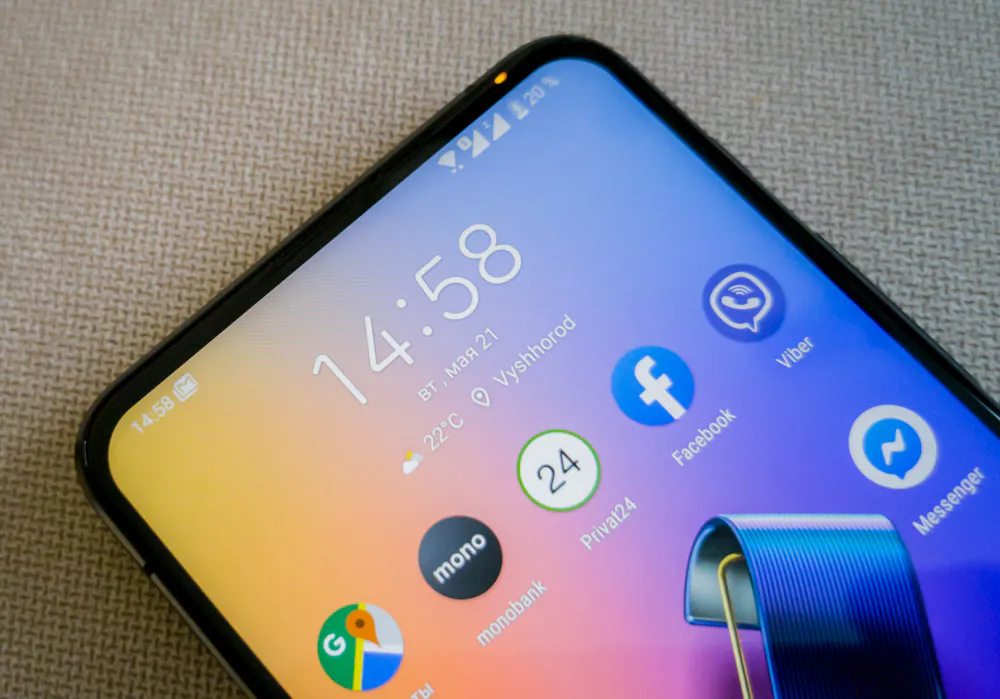
On the back you see double camera that’s located unusually high, dual flash and laser focusing module.
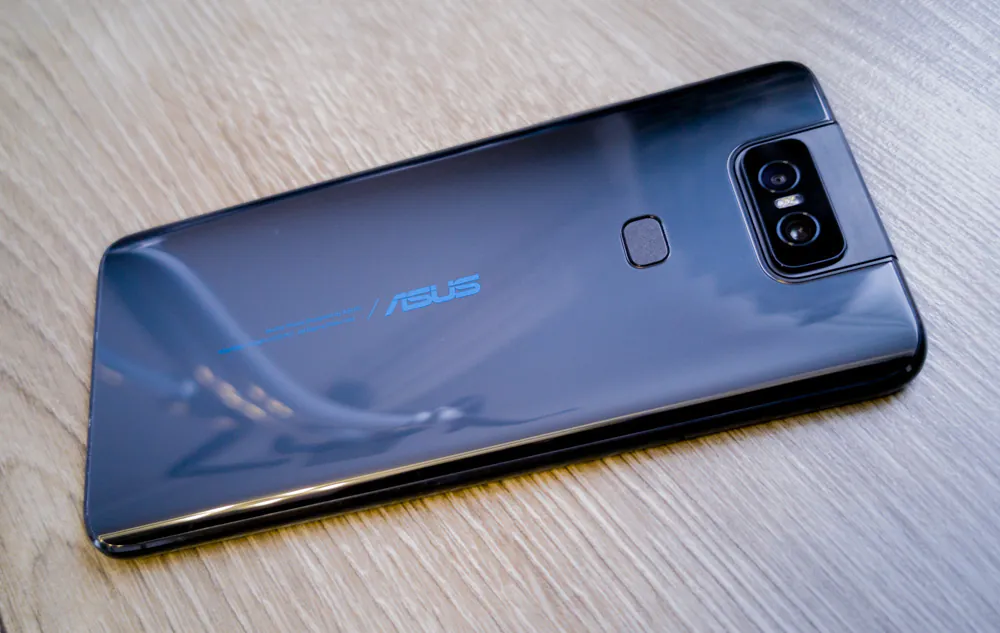
Undoubtedly, a motorized camera unit with a 180-degree turning unit is the main feature of the smartphone. And this is not just a functional element that turns the main camera into the front one. Transformable design of smartphones is still quite a fresh trend. And ASUS suddenly managed to get ahead in the effectiveness of its implementation. By the way, the case of the rotary unit is completely made of metal. According to the manufacturer, Liquidmetal Technologies alloy is used – light, but at the same time very durable.
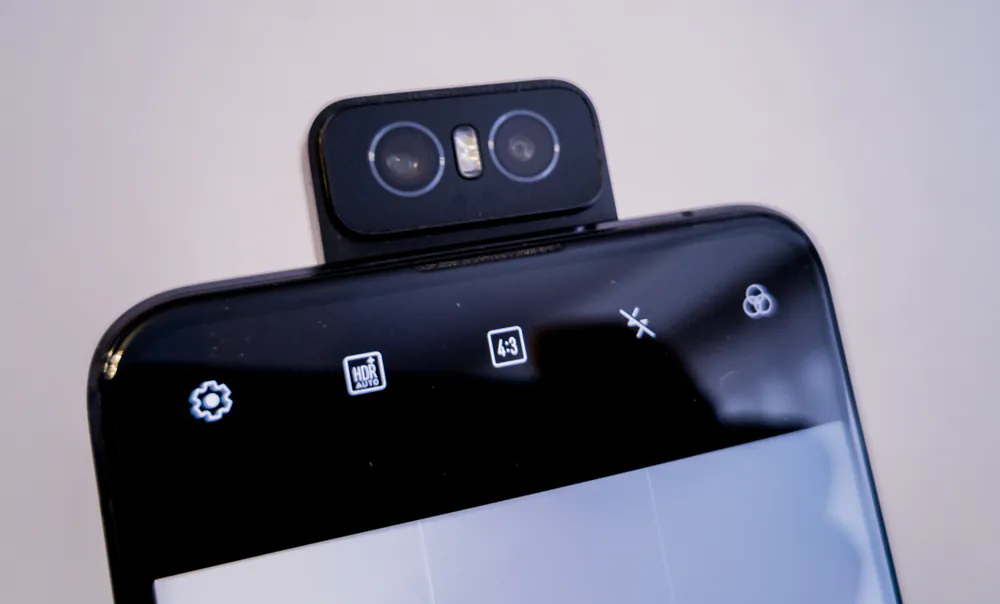
In the process of transformation, there is a considerable wow effect that can surprise others. If you purchase a smartphone, then you will most likely launch the front-facing camera often, at least at first. Fortunately, the manufacturer boasts about possible 100 thousand actuations of a motorized mechanism, which is about 9 years of operation if you use selfie camera 30 times a day. Smartphones do not live as much in our time, so it’s more than enough.
Also, if you are concerned about the safety of the smartphone and cameras during operation, it is worth noting that the turning mechanism is controlled by the accelerometer and has the function of emergency folding in case you drop the device. The cameras will quickly return to their original position before the smartphone falls to the surface. Also, the camera can be folded manually and it does not affect the performance and durability of the mechanism.
Below the camera is a classic fingerprint scanner – it is rectangular with rounded corners; it’s only slightly recessed into the body. Even lower is the azure horizontal logo of the manufacturer.
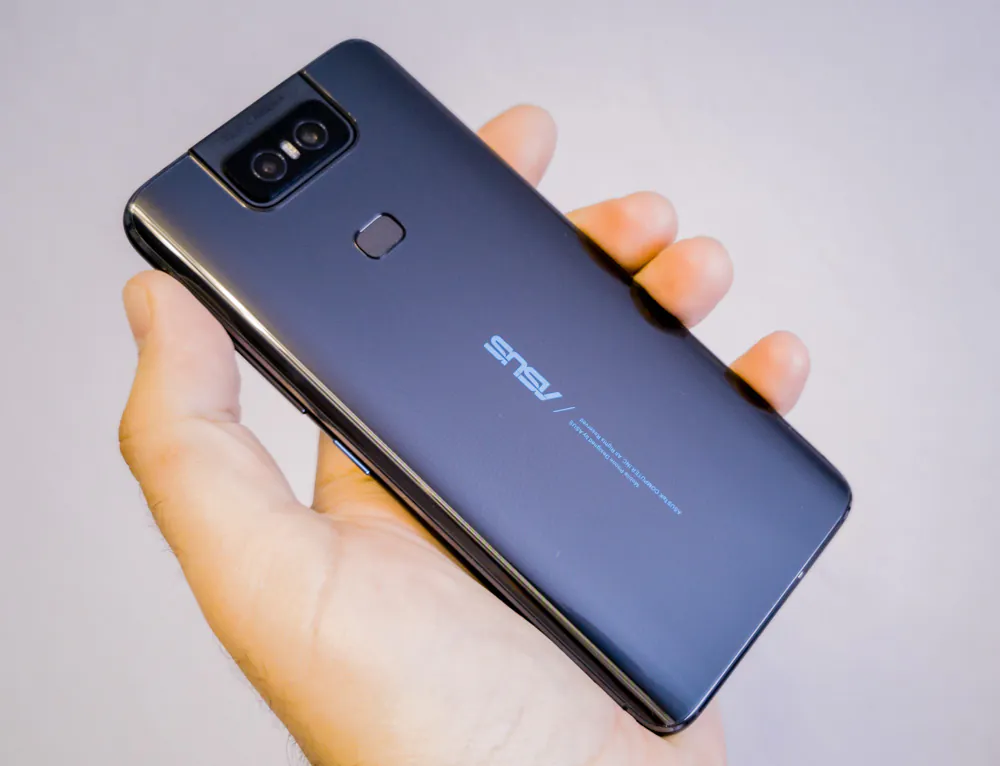
The glass behind (also Gorilla Glass, but the version is not reported) is slightly curved around the edges, it is not black, but rather dark gray with a blue-titanium sheen and has the effect of a wave-like reflection curvature to enhance the visual effect.
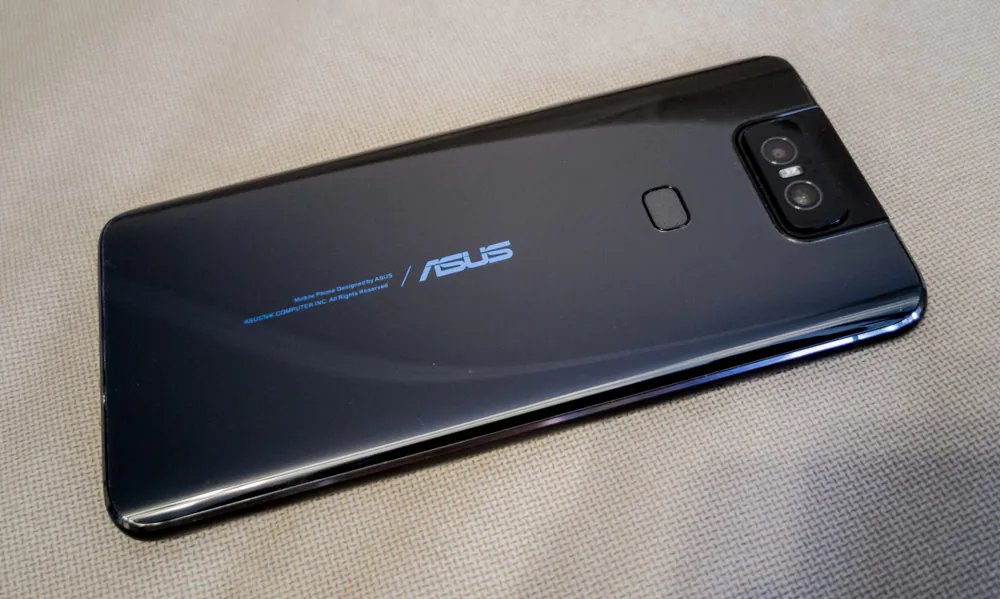
The metal frame is made of aluminum of the 6000th series and it is black in my version, but there are 2 shiny polished chamfers at the joints. This ASUS uses frequently, and not only in smartphones – it gives the product a touch of premium.
The physical buttons are also metallic and they are located on the right side. There are three of them. The power button is located below all and it has an azure chamfer, it looks cool. Further up comes the volume key. Above – an additional function button, the functionality of which will be explained later. On the left there’s only a tray for two SIM cards in Nano format with a separate place for a microSD card. Another plus of the smartphone.
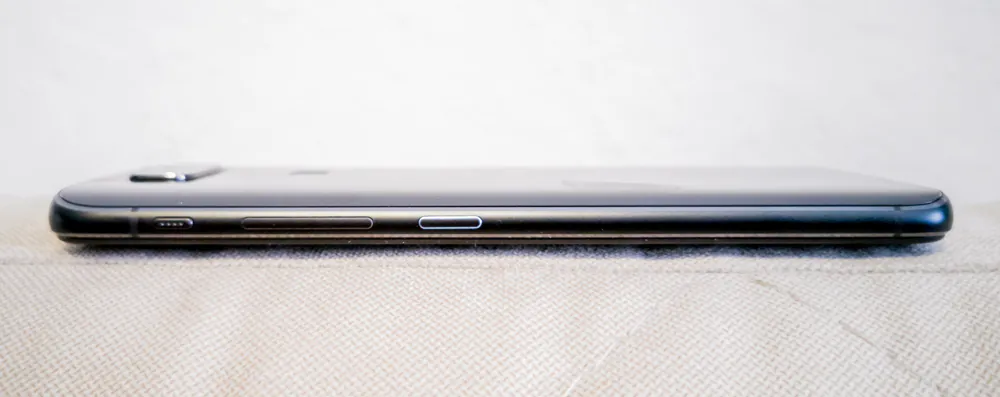
On the bottom, everything is as usual – a speaker, microphone, USB-C port and a 3.5 mm jack. Although, the last element can already be considered a rarity in the flagships. It was saved! And for someone, it can also be a significant advantage of ZenFone 6. Above we have only an extra microphone.
The build quality of the smartphone is excellent, I did not find any flaws in this regard. But there is one extremely unpleasant moment – the lack of moisture protection.
There is nothing special. ASUS ZenFone 6 is a typical flagship. I can only note that the smartphone comfortably lies in the hand due to the curved edges.
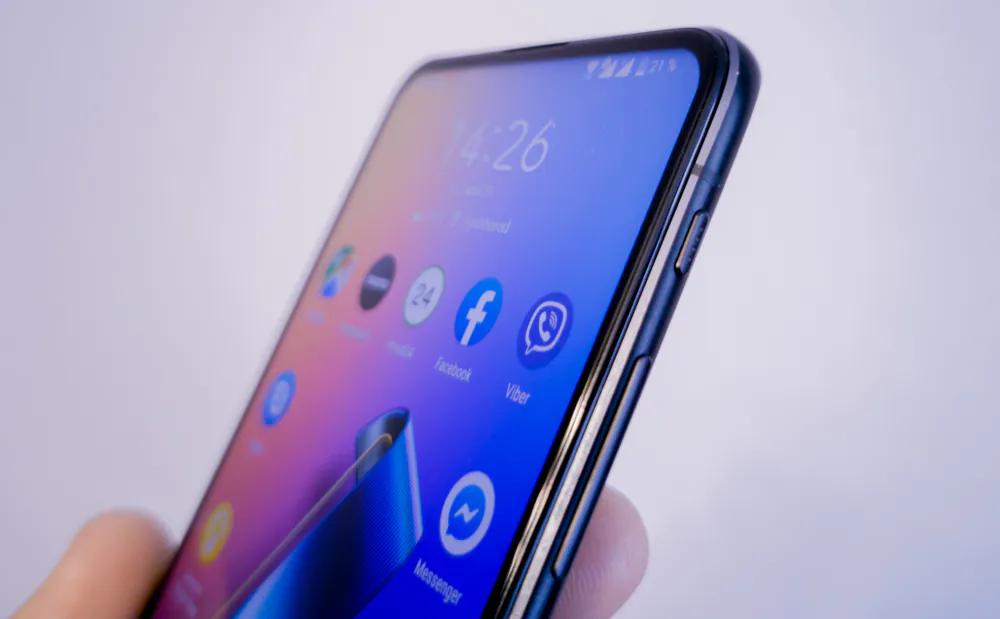
As for the oleophobic coating, behind it is weak, or maybe it’s not there at all. But the smartphone is not as slippery as it could be. Although, of course, it is no better in this regard than other glass-metal devices. Therefore, I personally used the smartphone with the bundled case. There is an oleophobic on the front of the screen and it is excellent.
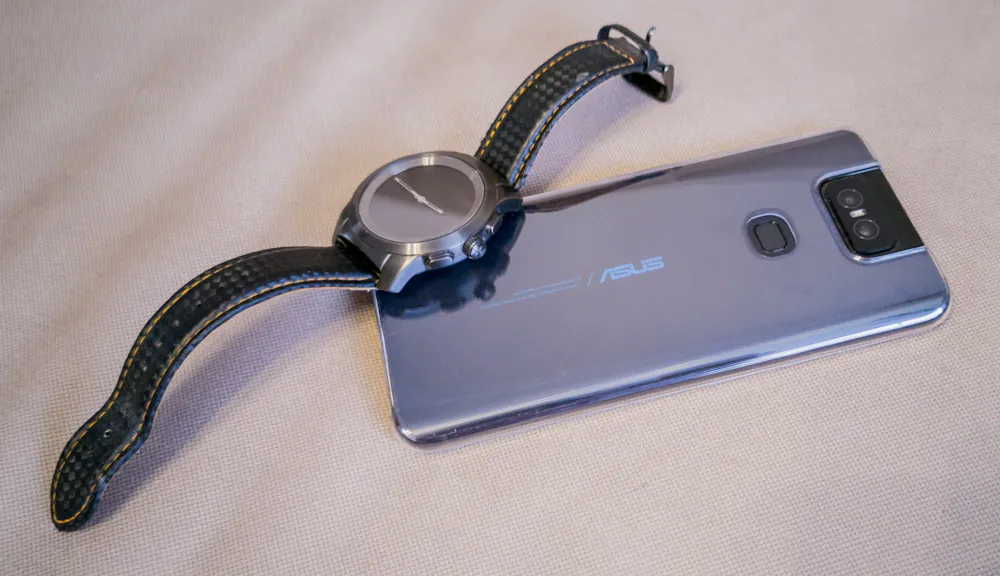
The buttons are also conveniently located in the right places. There’s an additional function button, which by default launches Google Assistant, but it can be configured with a short, long and double tap. For someone, this is a killer feature.
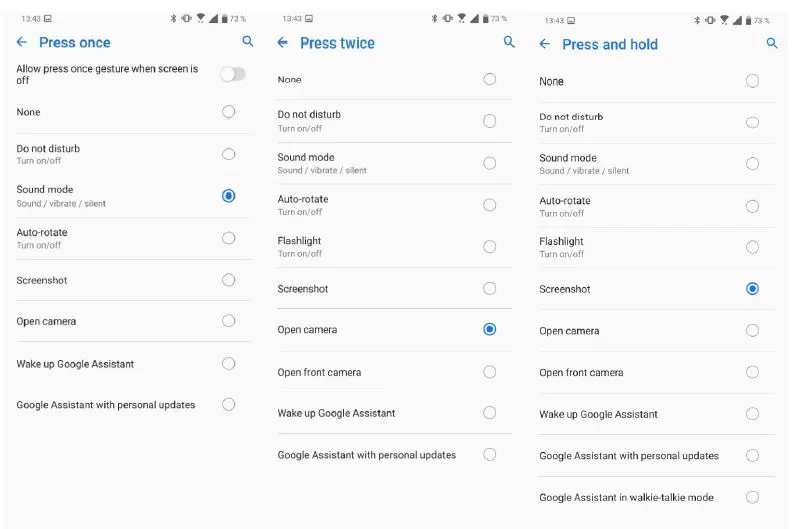
ASUS ZenFone 6 has classic on-screen navigation buttons, but in the settings you can switch to gesture control. The scheme, by the way, completely copies the solution from Samsung One UI shell. Just swipe from the bottom of the screen. Three zones are divided into actions.
Screen
Now, expect a surpise. ASUS ZenFone 6 is perhaps the only flagship smartphone of this year from the A-brand which uses IPS, and not OLED. Is it good or bad? You decide. Both technologies have their advantages and disadvantages. Let’s talk about this in more detail.
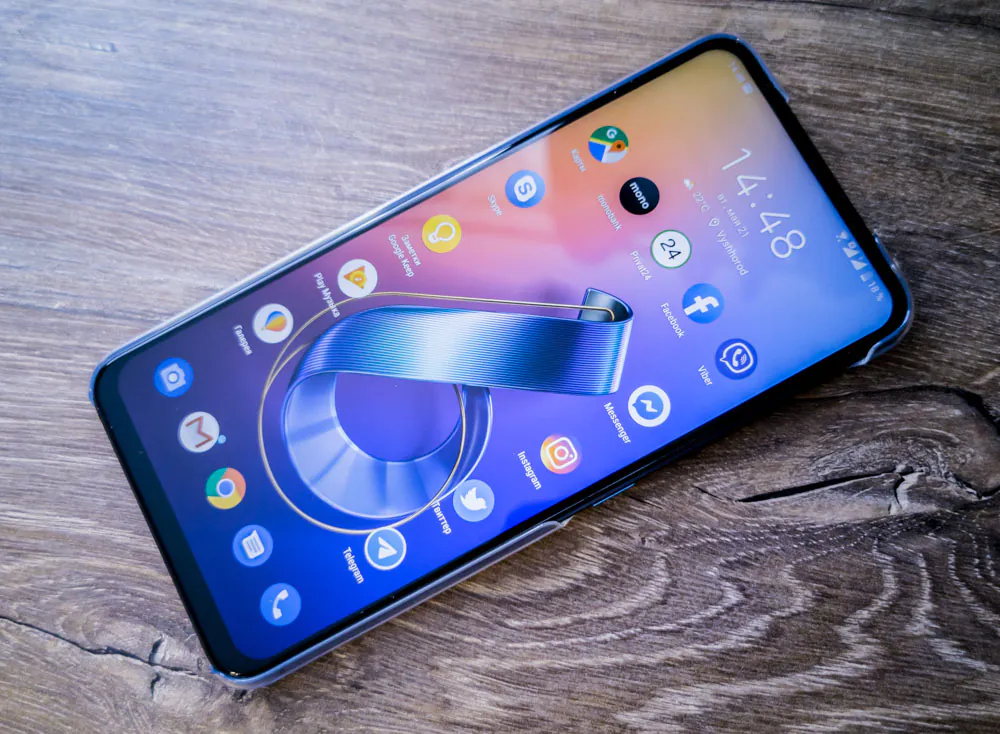
What’s better? There’s no easy answer. OLED technology, of course, has several advantages that manufacturers are happy to use. Smaller screen thickness means smaller thickness of the device itself, the ability to integrate a trendy screen scanner into the smartphone, as well as the ability to bend the display. Now it becomes clear why ZenFone 6 has a classic scanner.
OLED is also better for engineers – you can bend the matrix underneath and provide a connection under the screen, which reduces the thickness of the visible lower frame. With IPS, this focus cannot be done – hence the large lower frame, since you need to place the connector interface in this place, which, although a little, increases the overall dimensions of the device, which we observe in the example of ZenFone 6.
In addition, OLED (in theory) provides greater brightness and maximum contrast, greater color gamut and a wide dynamic range. But in practice, many consumers (including me) are tired of toxic saturated colors, they want a more relaxed color rendition. It is not in vain that smartphones with OLED screens usually have a second “natural” color rendition profile in addition to factory “saturated” colors in the settings menu.
There’s another inherent disadvantage of OLED. I’m talking about adjusting the screen brightness by changing the pixel frequency; the notorious PWM. Personally, PWM has no effect on me. However, there is a huge mass of people who suffer from this – their eyes get tired, there are headaches and other negative effects. In IPS (and LCD in general), the screen backlight is external; roughly speaking, this is a regular LED-bulb with simple brightness control.
In general, manufacturers are now beginning to deal with this problem and are trying to change the brightness adjustment of OLED screens using voltage. But it is quite difficult from a software and technical point of view, because you need to control the brightness of each pixel in real time (I remind you that there are about 2.5 million in Full HD screens), which requires changes at the kernel level of the system. Nevertheless, the process has begun and more and more manufacturers are beginning to use this method of brightness control.
I apologize for the lecture. Let’s go back to the IPS-matrix, which is installed in ZenFone 6. It is 6.4-inch with a resolution of 1080 x 2340 and a pixel density of about 403 ppi. The screen occupies approximately 92% of the frontal area. This screen offers a new generation of brightness of 600 nits with support for DCI-P3 100% coverage and HDR10 standard. In general, the color rendition is not worse than any AMOLEDs – we’re at the height of the evolution of the “older” IPS-screens technology.
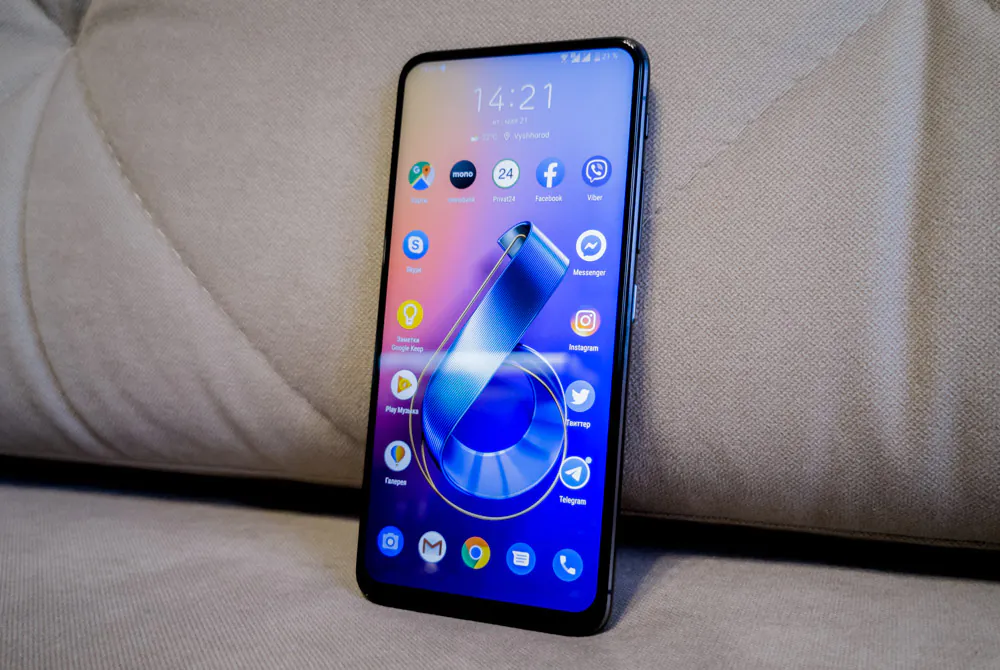
Actually, the screen is great. Although the maximum brightness (readability on a sunny street) is a bit lacking compared with OLED. In addition, for the second year I see a small flaw in the ASUS flagships – the white color from different angles begins turns red or blue. But this is observed at very large viewing angles, which have nothing to do with actual operation. In general – I liked the ZenFone 6 screen. Just because it is good old-fashioned IPS, it is very pleasant to use it. Your eyes will thank you.
In the settings of the screen there is a traditional color profile switching and color temperature adjustment. Saturated colors are used by default, but there is a natural color mode and fine tuning of color and saturation. Also, despite the fact that the smartphone uses an IPS screen, you can choose a dark theme. In addition, of course, there is a night mode with a blue filter that can be turned on manually or according to a schedule.
Performance
Snapdragon 855 means all is well. It is the best option on the market, no questions about it. In the week of operation of the smartphone, I noticed no signs of underperformance. The interface also works smoothly. The results of synthetic tests are below.
As for multitasking, I tested the version with 6 GB of RAM. By the way, it is super fast here, LPDDR4X standard. And with multitasking everything is fine as well. There is also a version of ZenFone 6 with 8 GB of RAM. But I can only advise it to those customers who need more than 64 or 128 GB of storage (UFS2.1) and require 256 GB. And even in this case, I recommend to remember the separate slot for memory cards up to 1 TB. If you really do not have enough internal memory.

In matters of games ASUS ZenFone 6 is the king and god. And not only because the Adreno 640, which is currently the most productive accelerator, is responsible for the graphics. The smartphone has a bunch of gaming features and a special gaming service that starts automatically when games are launched – Game Genie.
Besides the fact that the smartphone switches to a productive mode when launching games, this utility helps mobile gamers to immerse themselves in the gameplay by turning off notifications. But you will definitely not miss the incoming phone call – a pop-up window appears on the screen during the game with a choice of actions. Also, the feature is responsible for the constant display of the current FPS and the temperature of the smartphone. And here advanced tools for streamers have been introduced – you can record from the screen and stream the gameplay directly to Twitch or YouTube. Overall, ASUS ZenFone 6 is great for gaming.
Cameras
The smartphone has a dual main camera module. It also serves as the selfie camera, as you already know. This simplifies my work a little, as selfies are made with the same camera. From this point of view, ZenFone 6 can be considered one of the best options people who enjoy taking pictures of themselves.
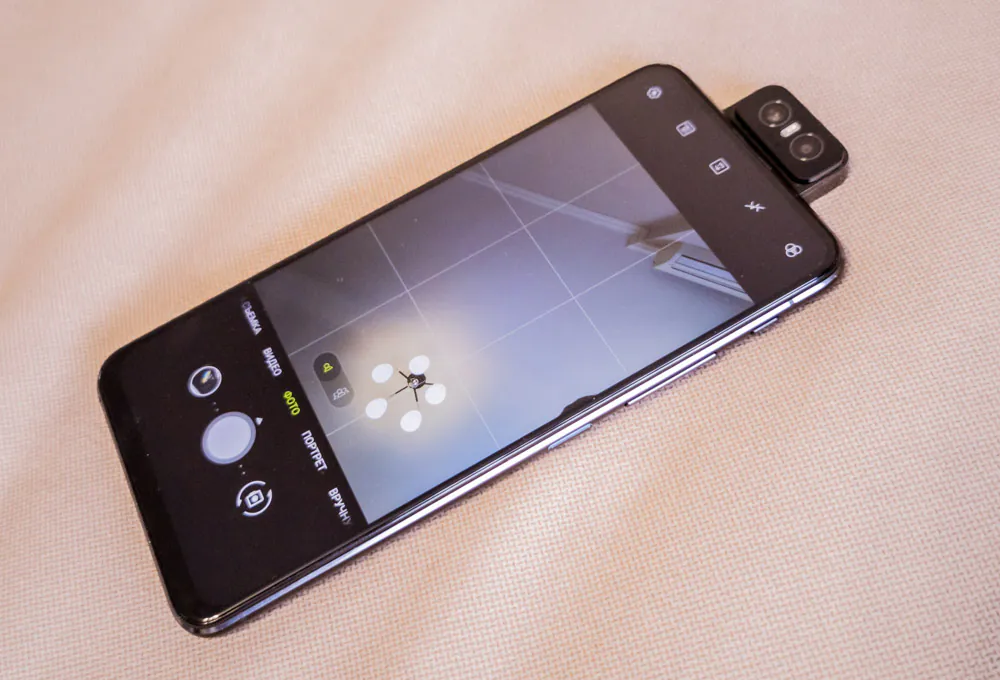
Now for the cameras themselves and the quality of the photos they take. Let me remind you that the first, the main module is IMX586 SONY with a f/1.8 aperture, 48-megapixel. However, by default it takes 12 megapixel images. In the settings you can switch the camera to 48 MP. There’s no real reason to do It though. Apart from the fact that the software of the camera starts to “think”, as a result, the picture is simply bigger – 8000×6000 instead of 4000×3000, but there is no serious improvement in the quality of the photo for the average consumer. Therefore, if you are not going to print pictures, then it is better to use the default resolution. For social networks such photos are more than enough.
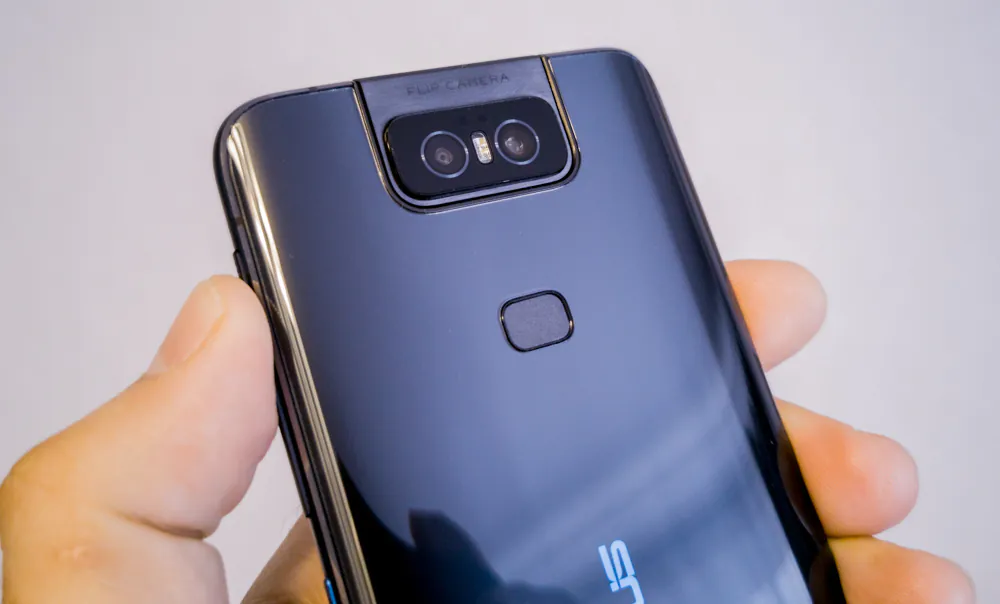
My overall impressions are: all is quite good. You can say even excellent with good lighting. In good lighting the macros also turn out alright. Portrait mode – no complaints at all, the face is properly separated from the background, which is blurred well, so the bokeh works fine. If the lighting is average, everything is also okay. Thanks to wide aperture the camera performs fine even in insufficient (dim) lighting.
SEE PHOTOS AND VIDEO EXAMPLES IN FULL RESOLUTION
But the camera has a limit: when it’s too dim, artifacts appear, as well as noise and poor detailing. Night shooting is clearly not the strong point of this smartphone. Despite the presence of a special night mode. This applies to both modules. The zoom is also present in the camera purely nominally; x2 is the max it can do.
SEE PHOTOS AND VIDEO EXAMPLES IN FULL RESOLUTION
Also, the HDR mode is not improved – deep shadows are a big headache for the camera.
The second module is 13 megapixel ultra wide angle. Its purpose is clear – to capture more objects in the frame and expand the scene. It is also useful when taking group selfies. The quality of the pictures, of course, is worse, but with good lighting the differences are hardly noticeable. As soon as the light dims, and especially when shooting at night, the difference becomes significant, since the ultra-width module is f/2.4. It is better not to use it in such conditions.
My conclusions on the cameras are as follows: at the moment, the ZenFone 6 camera does not reach the flagship smartphones from market leaders such as Samsung and Huawei. I would say that it’s one level higher than Redmi Note 7 or Huawei P30 Lite, the mid-rangers.
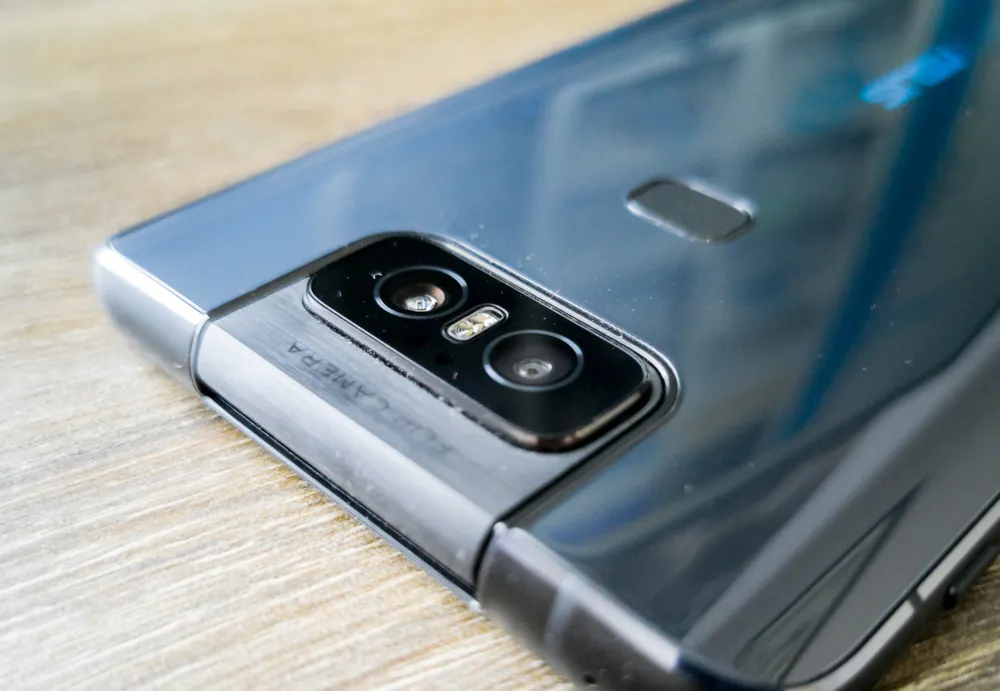
Perhaps the manufacturer will be able to modify the camera on the software level, we’ll see – this is often the case with ASUS and last year I saw a similar situation with ZenFone 5Z. I can say that the potential is definitely there. After I returned the smartphone to the representatives, a big update was released. As far as I know, it promised camera improvements. But I couldn’t check it for myself.
Another notable drawback of ZenFone’s camera is the lack of optical stabilization of the modules. This, of course, affects the quality of the photo and the shooting of the video. Although the cameras are equipped with an electronic stabilization system using a gyroscope.
By the way, the phones makes good video. Although at the moment there are restrictions on shooting time in Full HD 60 fps – up to 10 minutes and 4K 60 fps – up to 2 minutes. I hope it will also be eliminated soon. The video quality is decent, but only if you have a steady hand and normal lighting.
As for the camera software, it is both simple and functional. HDR+ is on by default, which according to my observations does not affect the speed of shooting. You can quickly turn off the mode on the main screen or switch to the Advanced HDR mode, which makes photos with more saturated colors.
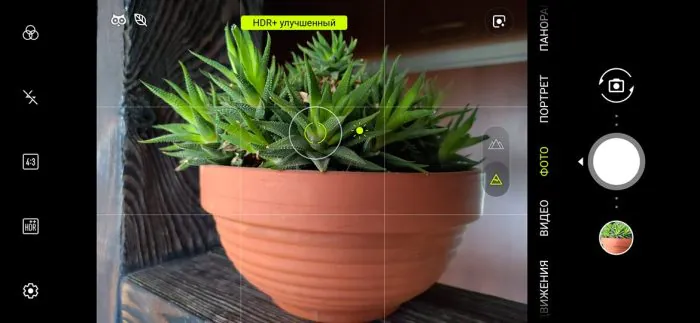
Also in the settings it is possible to enable automatic detection of scenes using AI, activate the quick launch of the camera from sleep mode, make snaps with the Smart-button.
A number of interesting features of the ASUS ZenFone 6 camera are associated with a swivel mechanism. Using the volume keys, you can manually expand the camera while taking a photo or video. Another camera can automatically monitor slow moving objects. In addition, auto-panorama mode also uses a motorized camera to create pictures with an angle of 180 degrees – both in a horizontal and vertical position. This is convenient because you can fix the smartphone and make a perfect panorama due to the smooth movement, instead of turning the smartphone with your hands.


Battery life
Not surprisingly, having a 5000 mAh battery, ASUS ZenFone 6 easily conquers the title of the most autonomous flagship of 2019. No one even comes close.
In actual operation, I charged it completely in a week just once! I used the smartphone in my usual working mode, I took a lot of pictures with the camera and even checked the benchmarks. In short, the battery ZenFone is fantastic. You can count in 2-3 days of continuous work (without games, of course).
As for the charging speed, everything is in order here too, it is fast (Quick Charge 4.0). In fact, in 30 minutes of charging, you can get a full day of work. Of course, Huawei P30 Pro is faster, but still … Here is the charging schedule for the 18W bundled adapter:
- 00:00 – 10%
- 00:10 – 21%
- 00:20 – 32%
- 00:30 – 43%
- 00:40 – 53%
- 00:50 – 63%
- 01:00 – 73%
- 01:10 – 82%
- 01:20 – 89%
- 01:30 – 94%
- 01:40 – 97%
- 01:50 – 100%
In addition, ASUS ZenFone 6 can perform the function of reverse charging, it can be used as a power bank. Unfortunately, wireless charging is not supported – the real minus of the smartphone.
Unlocking Methods
As you already understood, the fingerprint scanner is located behind, which is no longer fashionable. But it’s still reliable and quick. Believe me, the technology of in-screen scanners is currently far from perfect. In ASUS ZenFone 6 the scanner is lightning fast and almost never makes a mistake.
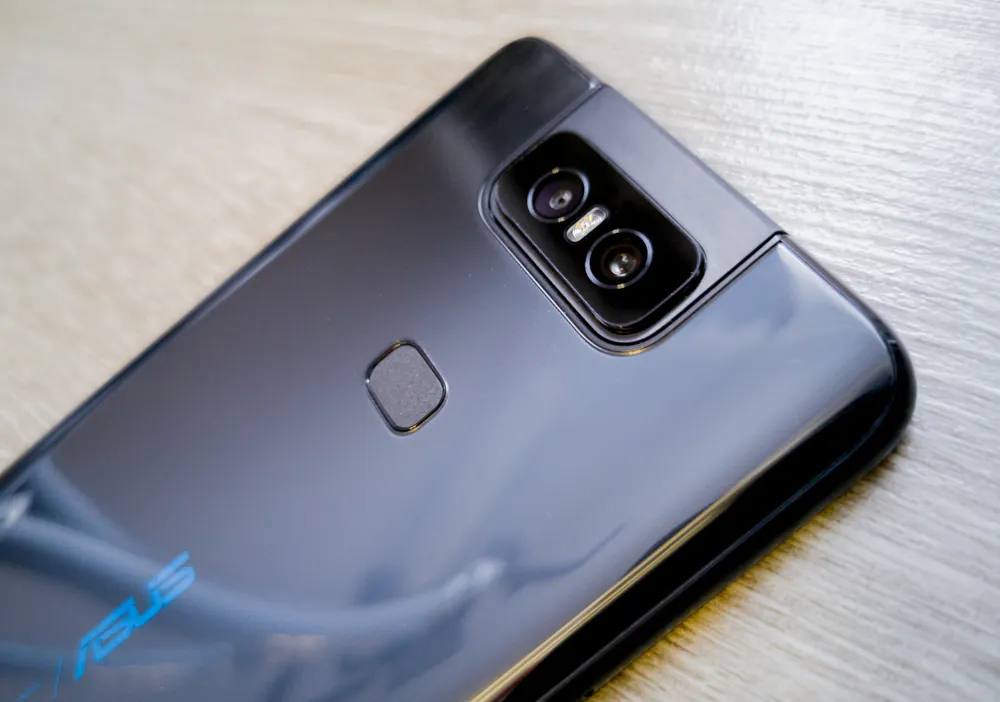
As for unlocking using face recognition, this function also exists and works quite fine although I didn’t find the way to start it automatically. The sequence here is this: press the power button – we get to the lock screen. And you need to press another screen button down below so that the camera turns to you and determines the face. In principle, recognition works quickly enough, despite the fact that some time is spent on turning the camera. In addition, the process looks very impressive and futuristic! People around you will pay attention to you and appreciate your smartphone.
Communications and equipment
In this aspect, everything is as you might expect from a flagship. Just check the detailed table at the beginning of the review. Wi-Fi dual-band, Bluetooth (5th version), a full set of geoposition services. There is even FM radio. And of course, there is an NFC module for contactless payments and connecting compatible devices. The only thing that’s missing is the infrared port.
Sound
Here, everything is also great. The smartphone supports stereo sound. The first speaker, as usual, is located on the bottom. It’s loud, with a wide frequency range. The earpiece speaker acts as the media speaker as well. It is much quieter than the first and the sound quality is not so high. But it creates the stereo effect. In general, ASUS ZenFone 6 sounds great, so you can enjoy watching videos and playing games on it.
In addition, the smartphone is equipped with a sound chip that supports Hi-Res Audio 24-bit/192 kHz and DTS Headphone X effects. And do not forget, it has a standard 3.5 mm audio jack for connecting wired headphones. The sound when listening to music is really impressive.
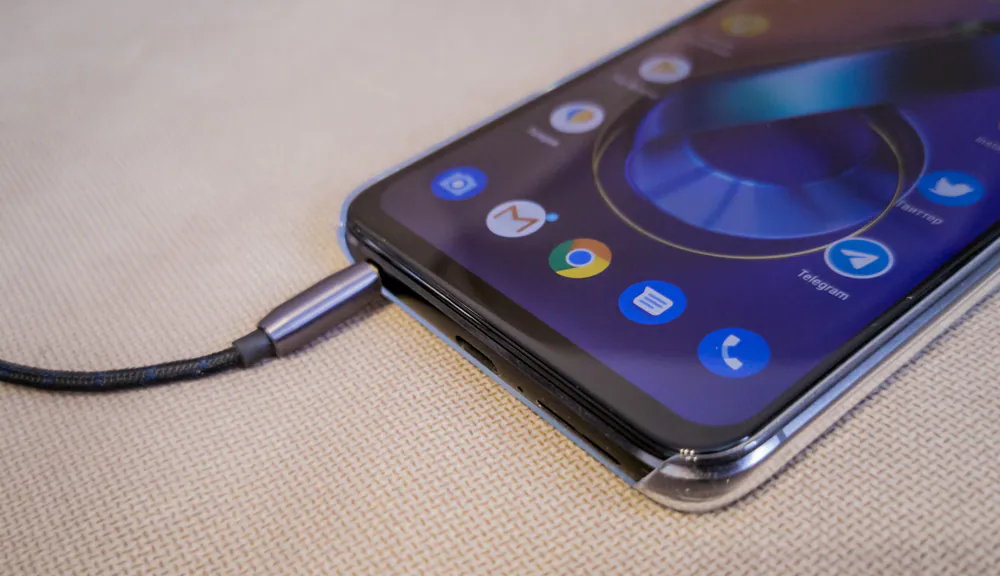
To customize the sound in your smartphone, you have ASUS AudioWizard software with an equalizer that allows you to create a personal sound profiles for each pair of headphones.
With wireless headphones and headsets, everything is also excellent – modern aptX HD, aptX Adaptive and LDAC are supported by the smartphone.
Firmware and software
ASUS ZenFone 6 runs on Android 9, wearing a proprietary Zen UI shell. By the way, the manufacturer promises 2 major updates for this smartphone – up to Android 10 this fall and then Android 11, when it will be released. In addition, for at least two years, the smartphone will receive security updates every 2 months.
The smartphone interface resembles pure Android. The lock screen, desktop, notification curtain and application icons are all made in the notorious Material Design. As I said, there are light and dark themes.
Also, Zen UI is literally crammed with unique features that are really useful and functional. In addition to the tools we considered earlier, there are themes and icons styles, wide customization of functions and appearance of various interface elements, support for gestures and movements, the Mobile Dispatcher utility for cleaning and optimizing a smartphone. There is also a proprietary Android 9 feature, “Digital Well-being”, which collects statistics. There is also a Twin Apps setting for working with different accounts in social networks and instant messengers. And much more. The interface is beautiful and convenient, the software works stably, which, in fact, is traditional for ASUS smartphones.
Verdict
ASUS ZenFone 6 is a very interesting flagship. If OLED (AMOLED) is something you actively despise, then ZenFone 6 is probably the only flagship for you, since it has an IPS screen. The front is all screen and no cameras or notches.
ZenFone boasts the best battery life and it is one of the most powerful phones out there, thanks to Snapdragon 855. Stereo sound and good communication capabilities – the device has lots to offer. But the main feature is its remarkable rotating camera.
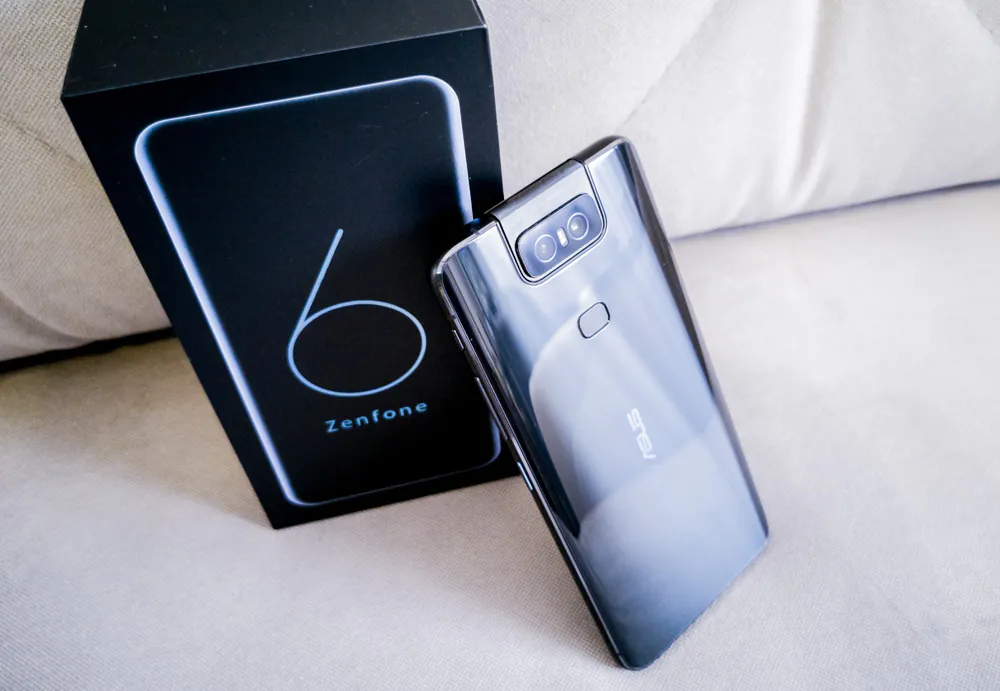
Unfortunately, ASUS ZenFone 6 is not uncompromising. It has cons: no water resistance or wireless charging. Also no in-screen scanner, which can be a good thing, too. The camera does great job in daylight, but at night it’s worse than other flagships. I hope this moment will be improved in the future.
On the other hand, ZenFone 6 is affordable compared to rival flagships. This makes it even more tempting for people who don’t care about the camera. Like those who want a gaming phone.
Subscribe to our accounts:


